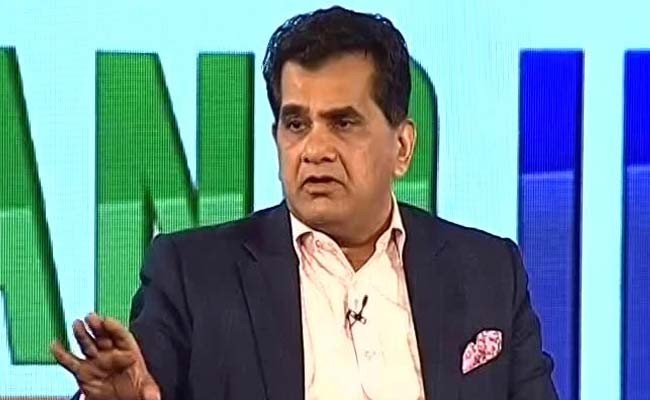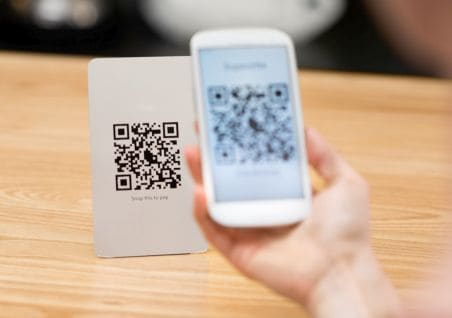- Cashless Bano India/
- Features/
- India's Digital Payments Infrastructure Is 5 Years Ahead Of The United States: Amitabh Kant
India's Digital Payments Infrastructure Is 5 Years Ahead Of The United States: Amitabh Kant

New Delhi: 86 per cent of India's transactions are done in cash while India spends 1.7 per cent of its GDP just on printing notes and another Rs 21,000 crore on circulating them. These figures were presented by Amitabh Kant, CEO of policy think-tank, NITI Aayog at the launch of the NDTV-Mastercard Cashless Bano India. This makes India one of the biggest informal economies in the world. However, Mr Kant went on to express his confidence that India would transition to digital payments thanks to the increasing penetration of smartphones, the fact that almost all Indians had biometrics and its position as the only country with a unified payments interface.
"We are on the threshold of a major revolution. My view is that is the next three to four years India will technologically leapfrog with most of us using either our iris or our thumb impression (for transactions) simply because it will be very easy. All of us already have our Aadhaar numbers," said Mr Kant.
Digitising payments is something that is widely considered to be one of the best solutions to unify and formalise India's economy while promoting financial inclusion. This is based on the internet and telecom services' ability to reach a larger population as well as remote areas, unlike traditional financial and banking services.
This is something Mr Kant reiterated, stating that banks in their physical form will soon be dead.
The NITI Aayog CEO also explained that for India to achieve its dream of becoming a $10 trillion economy, it would have to move towards digital payments. Having a formal economy and a parallel cash economy together would not work. Digital payments could also widen the government's tax net.
"It (digital payments) will ensure that India's tax base increases. Many people who do not pay taxes will come into this net and become honest taxpayers," said Mr Kant.
Technological Innovation to Drive Move Towards Cashless Economy
"Our digital payments infrastructure is five years ahead of the United States," Mr Kant said. He added that he was very pleased with the rate of innovation in the fin-tech space and that Indians today had plenty of options to go digital from UPI (Unified Payments Interface) which integrates multiple banking features into one app, USSD (Unstructured Supplementary Service Data) which enables mobile banking for users who do not have smartphones or mobile data to mobile wallets, credit/debit cards and internet banking.
According to government estimates, India currently has over 450 million smartphone users and another 250 to 300 million people with mobile phones.
Mr Kant explained that the government's ambition was to convert these into "banks and wallets" for everyone by leveraging these tech-based digital payments solutions.
"In due course, we will see that each one of us with a mobile phone will become a walking ATM," he said. Proof of this, according to Mr Kant, can be seen in the popularity of the government's BHIM App, a UPI-based mobile application which was launched by Prime Minister Narendra Modi in December 2016, over a month after Demonetisation (which in itself was a huge boost for the adoption of digital payments in India). In the past five months, the app has been downloaded 23 million times.
Mr Kant claimed that this was a world record and no other app in the world had ever received such an enthusiastic response. He also addressed concerns that people had returned to their old habits of using cash once the impact of Demonetisation wore off, saying that while there was a small dip in digitisation for two months, the adoption of digital payment solutions was on the rise once again.
Hurdles
One of the biggest hurdles to getting all Indians on the digital payments bandwagon is that a significant chunk of the population still does not have access to the internet and digital and financial literacy remains low. A report by industry body Assocham, released in December 2016 estimated that as many as 950 million Indians did not have any kind of internet access.
Mr Kant said that this was something that the government recognised and was looking to remedy.
"There is a big challenge of infrastructure at the back but this year the government is committed to connecting 1.5 lakh panchayats and next year another 1.5 lakh panchayats. Another thing that we have done to fast track this is converting public areas into Wi-Fi hotspots so that Aadhaar enabled payments can be done," said Mr Kant.
"We are moving from a low volume, high transaction cost to a high volume, low transaction cost regime," he added, "The age of the physical bank is over. The march of technology is inevitable," he concluded.
"We are on the threshold of a major revolution. My view is that is the next three to four years India will technologically leapfrog with most of us using either our iris or our thumb impression (for transactions) simply because it will be very easy. All of us already have our Aadhaar numbers," said Mr Kant.
Digitising payments is something that is widely considered to be one of the best solutions to unify and formalise India's economy while promoting financial inclusion. This is based on the internet and telecom services' ability to reach a larger population as well as remote areas, unlike traditional financial and banking services.
This is something Mr Kant reiterated, stating that banks in their physical form will soon be dead.
The NITI Aayog CEO also explained that for India to achieve its dream of becoming a $10 trillion economy, it would have to move towards digital payments. Having a formal economy and a parallel cash economy together would not work. Digital payments could also widen the government's tax net.
"It (digital payments) will ensure that India's tax base increases. Many people who do not pay taxes will come into this net and become honest taxpayers," said Mr Kant.
Technological Innovation to Drive Move Towards Cashless Economy
"Our digital payments infrastructure is five years ahead of the United States," Mr Kant said. He added that he was very pleased with the rate of innovation in the fin-tech space and that Indians today had plenty of options to go digital from UPI (Unified Payments Interface) which integrates multiple banking features into one app, USSD (Unstructured Supplementary Service Data) which enables mobile banking for users who do not have smartphones or mobile data to mobile wallets, credit/debit cards and internet banking.
According to government estimates, India currently has over 450 million smartphone users and another 250 to 300 million people with mobile phones.
Mr Kant explained that the government's ambition was to convert these into "banks and wallets" for everyone by leveraging these tech-based digital payments solutions.
"In due course, we will see that each one of us with a mobile phone will become a walking ATM," he said. Proof of this, according to Mr Kant, can be seen in the popularity of the government's BHIM App, a UPI-based mobile application which was launched by Prime Minister Narendra Modi in December 2016, over a month after Demonetisation (which in itself was a huge boost for the adoption of digital payments in India). In the past five months, the app has been downloaded 23 million times.
Mr Kant claimed that this was a world record and no other app in the world had ever received such an enthusiastic response. He also addressed concerns that people had returned to their old habits of using cash once the impact of Demonetisation wore off, saying that while there was a small dip in digitisation for two months, the adoption of digital payment solutions was on the rise once again.
Hurdles
One of the biggest hurdles to getting all Indians on the digital payments bandwagon is that a significant chunk of the population still does not have access to the internet and digital and financial literacy remains low. A report by industry body Assocham, released in December 2016 estimated that as many as 950 million Indians did not have any kind of internet access.
Mr Kant said that this was something that the government recognised and was looking to remedy.
"There is a big challenge of infrastructure at the back but this year the government is committed to connecting 1.5 lakh panchayats and next year another 1.5 lakh panchayats. Another thing that we have done to fast track this is converting public areas into Wi-Fi hotspots so that Aadhaar enabled payments can be done," said Mr Kant.
"We are moving from a low volume, high transaction cost to a high volume, low transaction cost regime," he added, "The age of the physical bank is over. The march of technology is inevitable," he concluded.
Published: May 24, 2017 12:37 IST
About The Campaign

NDTV along with MasterCard is launching a multi-platform campaign “Cashless Bano India”, to create digital awareness and educate the masses about digital payment solutions for day to day transactions.
The campaign aims to take the message of a cash free India to the country, all while educating them on the ways and means to do it.
We aim to reach out to people and educate them on:
1). Digital and financial literacy
2). New generation digital payment solutions
3). Enabling merchants and consumers to understand and adopt secured and safe payment Solutions
4). Ease of usage at point of sales
Comments


